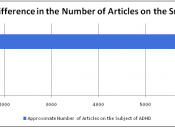ADHD, the abbreviation of Attention Deficit Hyperactivity Disorder was first identified by Dr. Heinrich Hoffman back in the year 1845. Dr. Heinrich Hoffman was a German physician and poet who wrote a poem about "Fidgety Phillip" whom couldn't sit still. The poem portrayed a typical child diagnosed with ADHD. Attention Deficit Hyperactivity Disorder in medical terms is a "syndrome", which means a set of symptoms which frequently takes place jointly. ADHD is commonly encountered by children and adolescents with learning disabilities. ADHD is divided into three subtypes which are inattentive, hyperactive-impulsive and combined ADHD.
Being diagnosed with ADHD "inattentive" subtype the individual makes careless mistakes, can't maintain attention, doesn't listen when spoken to, fails to finish tasks, seems disorganized, avoids tasks, loses things, easily distracted, and forgetful. As for being ADHD Hyperactive-impulsive subtype the criteria would be fidgety, leaves seat in classroom or dining table, runs or climbs excessively, can't play quietly, always "on the go," talks a lot, blurts out answers to a question, can't wait in line or take turns, and is often interrupting.
ADHD combined is just the criteria for both the subtypes, inattentive and hyperactivity-impulsive for a period of six months or more. ADHD rarely occurs alone because there are disorders that occur. Disorders such like headaches, seizures, tic or Tourette syndrome, and speech and language and motor coordination problems.
The causes for ADHD are numerous and vary and at times there are no causes at all. ADHD in a majority of cases is idiopathic or of unsure cause. Idiopathic, is a disorder of an unknown cause, possibly genetic or an environmental cause. Causes of ADHD are categorized by their time of occurrence: a) before birth (prenatal); b) at or near the time of birth (neonatal); c) after birth (postnatal). Prenatal causes, for example, arachnoid cysts,


